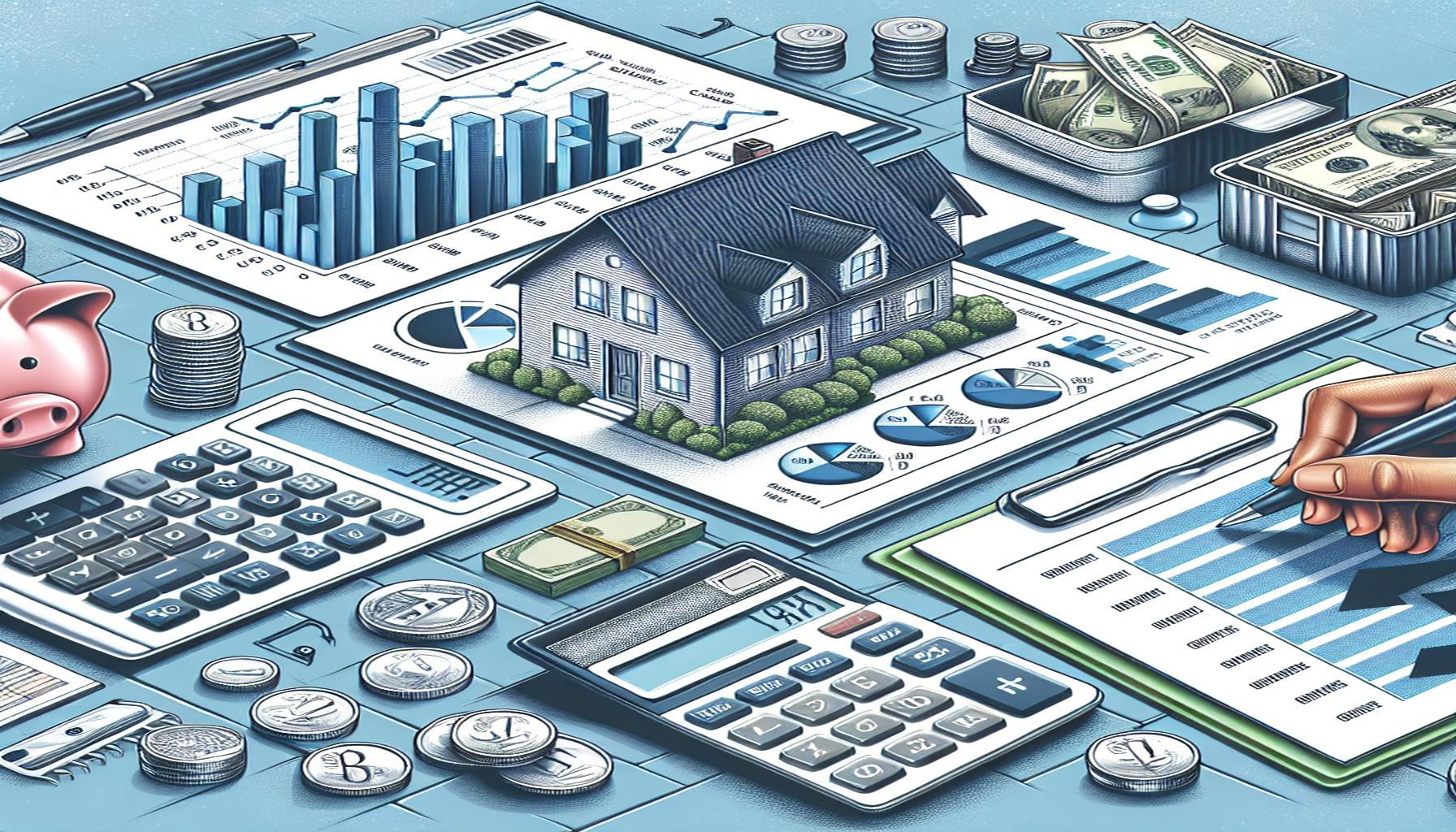How to create an efficient household budget from scratch

Understanding the Importance of a Household Budget
Creating a household budget is an essential skill that can lead to financial peace of mind. An effective budget acts as a financial roadmap, guiding you on how to manage your money wisely, keep track of your spending habits, and plan for future expenses. By having a clear view of your financial situation, you empower yourself to make informed decisions that can ultimately improve your quality of life.
Key Components of a Household Budget
To get started on your budgeting journey, it’s crucial to focus on the following key components:
- Income: Begin by identifying all sources of income. This includes not just your primary salary, but also any side jobs, freelance work, or passive income streams such as rental properties or dividends. For instance, if you have a side hustle as a graphic designer that brings in an extra $500 a month, include this in your total income calculation.
- Expenses: Next, categorize your spending into fixed and variable expenses. Fixed expenses are those that remain constant each month, like your rent or mortgage, car payment, and insurance premiums. Variable expenses, on the other hand, fluctuate month-to-month, such as groceries, dining out, and entertainment costs. Tracking your spending for a month can help you get a clearer picture of where your money goes.
- Goals: Setting both short-term and long-term financial goals is crucial for effective budgeting. Short-term goals may include saving for a vacation or building an emergency fund, whereas long-term goals could involve saving for retirement or a child’s education. For example, if you aim to save $5,000 for a family vacation in two years, you will need to save approximately $208 a month to meet that target.
The Benefits of Budgeting
A well-structured budget not only helps you understand where your money is spent but also empowers you to make informed financial decisions. By tracking your income and expenses diligently, you can easily identify areas where you can cut back and save more. For example, if you notice that you frequently overspend on dining out, you might choose to limit restaurant visits and cook at home instead, which could save you hundreds of dollars annually.
In this article, we will walk you through step-by-step instructions on how to design a budget tailored to your unique financial situation. You’ll learn essential tips, practical tools, and strategies that can make budgeting more straightforward and less daunting. Utilizing budgeting apps or spreadsheets may simplify the process, allowing you to visualize your finances in real time.
By taking control of your finances through effective budgeting, you set yourself up for a more secure and financially healthy future.
Steps to Create Your Household Budget
Creating an efficient household budget from scratch may seem overwhelming at first, but by breaking down the process into manageable steps, you can establish a clear financial plan that fits your lifestyle. Below are some practical steps to help you build a budget that works for you:
Step 1: Gather Financial Information
The first step in creating your budget is to gather all relevant financial documents. This includes pay stubs, bank statements, credit card statements, and any bills or invoices that show your regular expenses. Organizing this information will give you a comprehensive view of your financial standing.
Step 2: Calculate Your Total Income
Next, calculate your total income by adding up all sources of revenue. For individuals with a regular job, this usually means taking your monthly take-home pay (the amount after taxes and deductions). If you have multiple income sources, be sure to include them all. Here’s a simple formula to follow:
- Monthly Income = Salary + Side Hustles + Passive Income
For example, if your monthly salary is $3,000, you earn $300 from freelance writing, and you receive $150 from rental income, your total monthly income would be $3,450.
Step 3: Track and Categorize Your Expenses
Once you have an accurate picture of your income, it’s time to analyze your spending. Begin by categorizing your expenses into fixed and variable expenses. This allows you to see which costs remain the same and which can fluctuate. Here are common categories to consider:
- Fixed Expenses: Rent/mortgage, car payments, insurance premiums, and utility bills.
- Variable Expenses: Groceries, dining out, entertainment, shopping, and personal care.
Keeping track of these expenses over a month will reveal spending patterns that you might not have been aware of. Utilizing budgeting tools or apps can also streamline this process and help you organize your data efficiently.
Step 4: Analyze Your Spending Habits
With your income and expenses categorized, the next step is to analyze your spending habits. Look for areas where you can cut back or eliminate unnecessary expenditures. For instance, if you discover that you are spending an excessive amount on takeout, you may consider meal prepping at home to save both time and money.
It’s crucial to remain realistic when analyzing your spending. While cutting back is essential, do not impose overly restrictive measures that could lead to frustration. Instead, aim to find a balance that allows you to enjoy your life while staying within your budget.
By systematically walking through these steps, you will develop a robust understanding of your financial situation, which is fundamental for creating an actionable household budget. Once you have a clear picture of your finances, you can move forward to set your savings goals and ensure that your budgeting plan aligns with your lifestyle aspirations.
Setting Goals and Implementing Your Budget
After analyzing your spending habits and understanding your financial situation, the next crucial steps involve setting clear financial goals and implementing your budget. This process will help direct your spending in a manner that contributes to your long-term financial health and stability.
Step 5: Set Financial Goals
One of the most motivating aspects of budgeting is setting financial goals. These goals can be short-term, medium-term, or long-term. Short-term goals might involve saving for a vacation, while long-term goals may include buying a house or preparing for retirement. To create effective goals, consider using the SMART criteria—Specific, Measurable, Achievable, Relevant, and Time-bound.
For example, instead of saying “I want to save money,” you could set a goal to “save $2,000 in the next 12 months for a vacation.” This clarity gives you a clear target to aim for and allows you to adjust your budget accordingly.
Step 6: Develop Your Budget Plan
With your financial goals in mind, you can now draft your budget plan. Start with your total income, then deduct your fixed expenses, and finally, your variable expenses. The remaining amount is what can be allocated toward your savings and discretionary spending, such as entertainment or dining out. Here’s a simple budget formula:
- Budget = Total Income – (Fixed Expenses + Variable Expenses)
For instance, if your monthly income is $4,000 and your fixed and variable expenses total $3,200, you have $800 left for savings and discretionary spending each month.
Step 7: Monitor and Adjust Your Budget
Your budget is not static; it requires continuous monitoring and adjustments. At the end of each month, review your actual spending against your budgeted figures. Did you stay within the allocated budget for groceries? Did unexpected expenses arise? Understanding where you may have overspent or underspent will give you valuable insights into how accurately you budgeted and where adjustments might be beneficial.
To simplify monitoring, consider using budgeting software or apps tailored to your needs. These tools can provide visual breakdowns of your spending and make it easier to track your progress toward your financial goals.
Step 8: Create an Emergency Fund
As you implement your budget, it’s essential to prioritize building an emergency fund. An emergency fund typically contains three to six months’ worth of living expenses. This financial safety net can prevent you from falling into debt when unexpected costs arise, such as medical bills or car repairs. Allocating a specific portion of your monthly budget toward this fund can provide peace of mind and financial security.
Step 9: Review and Revisit Your Budget Regularly
Finally, make a habit of revisiting your budget regularly. At least once every few months, evaluate whether your financial goals have changed or if there are new expenses to account for. Life changes, such as getting married, having children, or changing jobs, can significantly affect your finances. Adapting your budget in response to these changes ensures that your financial plan remains relevant and effective.
By following these steps, you will build a comprehensive household budget designed to foster financial responsibility while helping you achieve your monetary goals. With dedication and consistency, your budget will guide you toward a more secure financial future.
Conclusion
Creating an efficient household budget from scratch is a transformative step towards achieving financial stability and peace of mind. By clearly understanding your income and expenses, setting SMART financial goals—which are Specific, Measurable, Achievable, Relevant, and Time-bound—you lay the groundwork for responsible spending and saving. For example, a specific goal could be to save $5,000 for a family vacation within a year, rather than just saying you want to save money. This clarity helps to keep your objectives in focus and makes it easier to track your progress.
When drafting your budget plan, consider categorizing expenses into fixed (like rent or mortgage payments) and variable (like dining out or entertainment). This division allows for better understanding and management of your finances. Remember, your budget is a living document; it requires frequent monitoring and adjustments to remain relevant in the face of life’s changes. For instance, if you receive a pay raise or if your child starts school, it’s essential to adjust your budget accordingly to reflect these new realities.
Equally important is the establishment of an emergency fund. This financial cushion safeguards you from unexpected expenses, such as medical bills or urgent home repairs, preventing disruptions to your budgeting efforts. A common recommendation is to save at least three to six months’ worth of living expenses in this fund, providing peace of mind during uncertain times.
Periodic review of your budget will enhance its effectiveness and keep you driven towards your financial objectives. It can be helpful to schedule a monthly budget meeting with yourself or your family to discuss progress, challenges, and any necessary changes. This practice not only ensures accountability but also helps develop a collaborative approach to financial decisions.
Ultimately, budgeting is not merely about restricting your spending; it is about empowering yourself to make informed financial decisions that align with your goals and lifestyle. Embrace this process with patience and persistence. With time, diligence, and sound practices, you will gain a deeper understanding of your financial position, leading to a more secure and fulfilling future. Through conscientious budgeting, you set the stage for long-term financial health and the ability to thrive instead of merely survive.

Linda Carter is a writer and financial expert specializing in personal finance and investments. With extensive experience helping individuals achieve financial stability and make informed decisions, Linda shares her knowledge on the Territorio Deficiente platform. Her goal is to provide readers with practical advice and strategies for financial success and smart investments.






